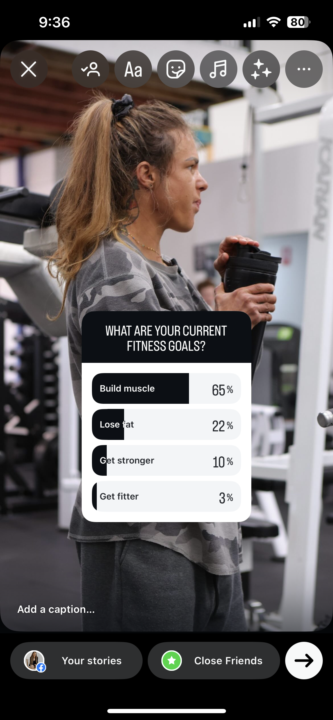
Write something
Pinned
Welcome!
Welcome to Peak Physique Skool! Introduce yourself, and let us know what bought you here and what you want to learn.
The problem with my latest Instagram poll
I put out a poll yesterday on IG, asking what peoples main goal was and what they were struggling with most. The majority said their goal was to build muscle and their struggle was with nutrition. Which tells pretty much tells me that most people just aren't training effectively. Because barring that your protein requirements are met and you are at or above maintenance calories then nutrition has very little to do with building muscle (of course it has its role in how you recover and what not) but you see my point. There is so much more that goes into training than just rocking up to the gym and moving a few weights around. I mean if you are doing that consistently, then probs to you. But if you are beyond the beginner stage than you have to be more methodical. You have to consider: Frequency Exercise order Session order Exercise selection Volume Intensity Recovery demands It would take me forever to cover each of these elements in detail but I did post an example of a quad focused program here: And of course, let me know if you want me to do a post expanding on anything https://www.instagram.com/reel/DOVhaWmk4bH/?utm_source=ig_web_copy_link&igsh=MXF5aXdkaHdqdmFrdQ==

Why Women Store More Belly Fat With Age (and What to Do About It)
Ever wondered why fat storage shifts as women get older...especially around the midsection? The short answer: hormones. More specifically, estrogen. Estrogen’s Role in Fat Storage and Appetite Estrogen (estradiol in particular) plays a big part in regulating appetite, body weight, and fat storage. When estradiol levels are high, you’re more likely to feel satisfied after eating, which makes it easier to keep food intake under control. But as estradiol declines—especially during menopause—that sensitivity drops. Making it easier to overeat and gain weight. On top of that, estrogen influences where fat is stored. With normal levels, fat is more likely to settle in subcutaneous areas like your hips and thighs. This isn’t ideal for aesthetics if you hate stubborn lower body fat, but metabolically it’s less risky. When estradiol falls, fat tends to shift toward the abdomen as visceral fat—the deeper fat that surrounds organs and raises the risk of health issues. Metabolism Slows Down Too Declining estrogen doesn’t just affect appetite and fat distribution—it also lowers your metabolic rate. That means fewer calories burned at rest and a higher likelihood of weight creeping on. This is why many women notice fat loss feels harder in their 40s, 50s, and beyond compared to their 20s or 30s. The Good News Harder doesn’t mean impossible. You can still drop body fat—it just requires a smarter, more intentional approach. The basics still apply: - Lift heavy weights to hold onto muscle and keep metabolism higher. - Eat enough protein to support recovery and control hunger. - Do cardio to help with calorie burn and cardiovascular health. These aren’t just “nice-to-dos.” They’re the most effective tools to manage body composition when hormones aren’t working in your favor. If you want to dive deeper, here’s a solid breakdown of the science: Frontiers in Endocrinology, 2022
Insulin for Females: What You Need to Know
Insulin gets a lot of attention in the fitness and health world, and for good reason. Often called the “storage hormone,” it plays a critical role in how your body handles food, energy, and even muscle growth. But insulin isn’t just about blood sugar control; for females especially, understanding its function and potential use in physique development can be a game-changer. What Insulin Actually Does Insulin is produced by the pancreas and released when you eat. Its primary job is to transport glucose (carbohydrates) into your cells so it can be used for energy. - When blood glucose levels rise, insulin helps stabilize them. - It also signals fat cells to store energy as triglycerides. - If insulin can’t attach to receptors on cells, glucose remains elevated in the bloodstream. Over time, the body pumps out more insulin, the pancreas becomes overworked, and this leads to insulin resistance. Beyond Blood Sugar: Why Insulin Matters in Physique Development Insulin’s influence goes far beyond energy storage: - Protein synthesis: Insulin itself doesn’t directly build muscle, but it primes the system. Amino acids are the true driver of muscle growth, and insulin makes sure those amino acids get where they need to go. - Vasodilation and blood flow: Insulin stimulates nitric oxide production, improving nutrient delivery to muscle tissue. - Hormonal synergy: Insulin enhances Growth Hormone (GH) and IGF-1 activity. It increases GH receptor expression, reverses IGF-1 desensitization, and improves the GH-to-IGF-1 conversion process. In short: insulin creates the environment for growth, but it doesn’t act alone. When Would Insulin Use Be Considered? In performance settings, insulin may be introduced strategically in the off-season, when food intake and androgen levels are at their peak. Common signs it may be useful include: - Increased lethargy - Reduced appetite - Slow digestion or GI motility - Diminished pumps during training The goal here isn’t reckless blood sugar manipulation, it’s about optimizing fasting blood glucose levels and taking pressure off the pancreas.
Are the Last Few Reps Really All That Matters for Muscle Growth?
If you have been told that only the last few reps in a set build muscle, you have already missed the bigger picture. Yes, the stimulating reps near failure are important, but hypertrophy is not about worshipping those final two or three reps in isolation. It is about the total stimulus of the set. What Actually Makes a Rep Stimulating? For a rep to truly drive muscle growth, two things need to happen. First, you need high motor unit recruitment, which means the largest and strongest muscle fibers are brought into play. Second, those fibers must be under enough mechanical tension to force an adaptation. These conditions usually overlap in the final reps before failure, which is why people fixate on them. But the reps that come before still matter. Why the Earlier Reps Still Count The first reps in a set are not wasted. They are creating fatigue, adding mechanical tension, and building the metabolic stress that sets the stage for those last reps to be effective. If only the final reps mattered, then a five-rep set would always beat a fifteen-rep set. That is not how it works. Heavy low-rep sets recruit high-threshold motor units sooner, while higher-rep sets build fatigue that eventually achieves the same thing. Both approaches can be effective, and the actual difference in hypertrophy between them is smaller than most people suggest. And remember, the first ten reps of a fifteen-rep set are still providing more hypertrophic stimulus than the first non existing rep of a 5 rep set. The Bigger Picture The constant debate about which rep range is best usually misses the point. If differences exist, they are minor compared to the impact of exercise selection, individual preference, and joint health. Some lifts are better suited to heavier weights for fewer reps. Others work best when you push into higher rep ranges. What you enjoy matters, because consistency drives progress. Recovery also matters, because constantly grinding heavy sets might wreck your elbows, while endless high-rep squats might hammer your lower back.
1-30 of 330

skool.com/peak-physique
Learn everything you need to know to achieve your best physique. Mindset, nutrition, training and yes... PEDs I've got you covered!
Powered by


